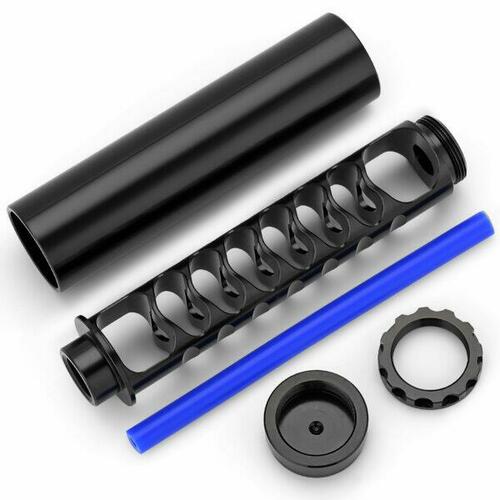
A new report from firearms website AmmoLand Shooting Sports News revealed the Bureau of Alcohol, Tobacco, Firearms and Explosives (ATF) sent an open letter to all federal firearm licensees (also commonly known as gun shops) that "solvent traps never existed under federal law and most have always been unregistered silencers."
However, in early 2022, the ATF unofficially considered solvent traps as suppressors (read: here), which allowed law-abiding gun owners who bought these devices and manufactured them into homemade suppressors to file a National Firearms Act "Form 1" with the ATF and pay $200 tax stamp to own them legally.
Now, according to AmmoLand's investigative reporter John Crump, the ATF's open letter sent to FFLs on Monday indicates these devices that attach to the end of a barrel, used to catch fluids from cleaning firearms, "never existed under federal law and most have always been unregistered silencers." He said the ATF has begun "rejecting all applications to make a suppressor."
"These traps can be purchased from various retailers, notably Chinese websites like Aliexpress and Wish. Many Americans purchased these items to legally convert solvent traps into suppressors, but the ATF claims the term does not exist in its regulations," Crump said.
"'Solvent traps' are marketed as devices that attach to firearm barrels to catch excess solvent used when cleaning firearms," the letter reads. "ATF has not classified any device as a 'solvent trap,' because that term does not exist in the relevant Federal statutes or implementing regulations.
Here's more from Crump's reporting:
One example the ATF gives is if there is an indentation that can be used as a drill guide. The agency states that these index markings have no purpose other than showing users where to drill to convert a solvent trap into a suppressor. This reasoning is similar to the ATF stating that an AR-15 with an index mark for the third hole is considered a machine gun. The ATF says that the solvent trap might still be a silencer even without indexing.
Other features that the ATF says make a solvent trap a suppressor are baffles, spacers, ported inner sleeve or tube, expansion chamber, end caps, and dampening material. In the eyes of the ATF, any of these could turn a law-abiding citizen into a felon facing ten years in prison and a $250,000 fine. This penalty is the same as being caught with an unregistered machine gun.
"Other such characteristics may include baffles, spacers, ported inner sleeve or tube, expansion chamber, end caps, and dampening material, depending on the particular design of the device," the ATF says. "While increasing the effectiveness of a firearm silencer, these same objective design features offer no advantages in collecting or filtering cleaning solvent."
And then there's this... The ATF appears to be broadening its definition of "suppressors," possibly labeling end caps as suppressors. Crump goes into detail about this troubling development:
The ATF says that end caps by themselves are suppressors, even if an end cap is the only part an end-user has. The ATF clearly believes that a silencer does not have to be complete or functional before the owner crosses the line. Just the mere possession of a single part can send a person to prison if the ATF decides to prosecute.
The ATF also claims that users with solvent traps can not legally convert them into suppressors even if they complete the proper paperwork. Its reasoning is the originating company already created an unregistered suppressor and didn't go through the appropriate steps to transfer it. Once those steps are skipped, they can never be made legal in the eyes of the ATF.
"Over the years, many companies involved in marketing such' solvent traps' have asserted that they are permitted to manufacture, transfer, or import these items because they are not yet 'complete' and therefore do not qualify as 'firearm silencers' under Federal law," the ATF writes. "However, this assertion is incorrect because a component of a 'firearm silencer' need not be fully functional before it is recognized as a 'part intended only for use' in assembling or fabricating a 'firearm silencer.'"
Many law-abiding Americans purchased these devices to legally convert solvent traps into suppressors by filing Form 1. But now the ATF claims these devices were always unregistered silencers.
Crump also explains in the video below how the ATF is broadening its definition of suppressor to include end caps.
Yet another move by Biden's rogue ATF to turn law-abiding Americans into felons overnight.
A new report from firearms website AmmoLand Shooting Sports News revealed the Bureau of Alcohol, Tobacco, Firearms and Explosives (ATF) sent an open letter to all federal firearm licensees (also commonly known as gun shops) that “solvent traps never existed under federal law and most have always been unregistered silencers.”
However, in early 2022, the ATF unofficially considered solvent traps as suppressors (read: here), which allowed law-abiding gun owners who bought these devices and manufactured them into homemade suppressors to file a National Firearms Act “Form 1” with the ATF and pay $200 tax stamp to own them legally.
Now, according to AmmoLand’s investigative reporter John Crump, the ATF’s open letter sent to FFLs on Monday indicates these devices that attach to the end of a barrel, used to catch fluids from cleaning firearms, “never existed under federal law and most have always been unregistered silencers.” He said the ATF has begun “rejecting all applications to make a suppressor.”
“These traps can be purchased from various retailers, notably Chinese websites like Aliexpress and Wish. Many Americans purchased these items to legally convert solvent traps into suppressors, but the ATF claims the term does not exist in its regulations,” Crump said.
“‘Solvent traps’ are marketed as devices that attach to firearm barrels to catch excess solvent used when cleaning firearms,” the letter reads. “ATF has not classified any device as a ‘solvent trap,’ because that term does not exist in the relevant Federal statutes or implementing regulations.
Here’s more from Crump’s reporting:
One example the ATF gives is if there is an indentation that can be used as a drill guide. The agency states that these index markings have no purpose other than showing users where to drill to convert a solvent trap into a suppressor. This reasoning is similar to the ATF stating that an AR-15 with an index mark for the third hole is considered a machine gun. The ATF says that the solvent trap might still be a silencer even without indexing.
Other features that the ATF says make a solvent trap a suppressor are baffles, spacers, ported inner sleeve or tube, expansion chamber, end caps, and dampening material. In the eyes of the ATF, any of these could turn a law-abiding citizen into a felon facing ten years in prison and a $250,000 fine. This penalty is the same as being caught with an unregistered machine gun.
“Other such characteristics may include baffles, spacers, ported inner sleeve or tube, expansion chamber, end caps, and dampening material, depending on the particular design of the device,” the ATF says. “While increasing the effectiveness of a firearm silencer, these same objective design features offer no advantages in collecting or filtering cleaning solvent.”
And then there’s this… The ATF appears to be broadening its definition of “suppressors,” possibly labeling end caps as suppressors. Crump goes into detail about this troubling development:
The ATF says that end caps by themselves are suppressors, even if an end cap is the only part an end-user has. The ATF clearly believes that a silencer does not have to be complete or functional before the owner crosses the line. Just the mere possession of a single part can send a person to prison if the ATF decides to prosecute.
The ATF also claims that users with solvent traps can not legally convert them into suppressors even if they complete the proper paperwork. Its reasoning is the originating company already created an unregistered suppressor and didn’t go through the appropriate steps to transfer it. Once those steps are skipped, they can never be made legal in the eyes of the ATF.
“Over the years, many companies involved in marketing such’ solvent traps’ have asserted that they are permitted to manufacture, transfer, or import these items because they are not yet ‘complete’ and therefore do not qualify as ‘firearm silencers’ under Federal law,” the ATF writes. “However, this assertion is incorrect because a component of a ‘firearm silencer’ need not be fully functional before it is recognized as a ‘part intended only for use’ in assembling or fabricating a ‘firearm silencer.'”
Many law-abiding Americans purchased these devices to legally convert solvent traps into suppressors by filing Form 1. But now the ATF claims these devices were always unregistered silencers.
Crump also explains in the video below how the ATF is broadening its definition of suppressor to include end caps.
[embedded content]
Yet another move by Biden’s rogue ATF to turn law-abiding Americans into felons overnight.
Loading…





